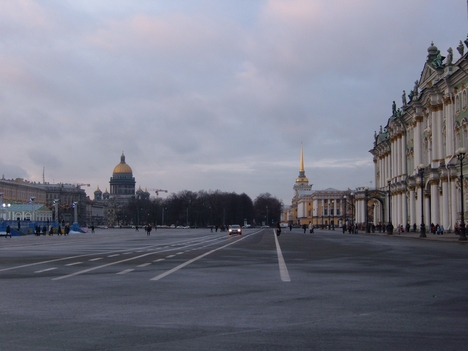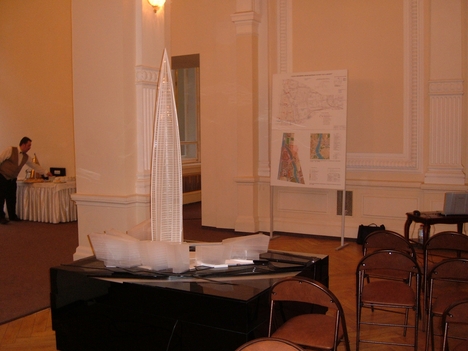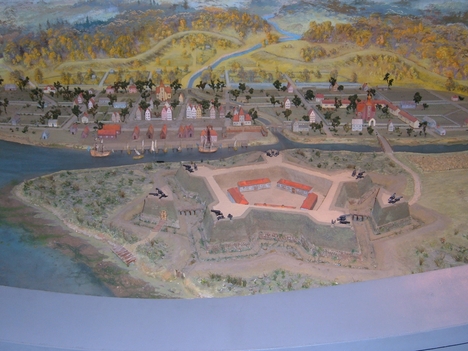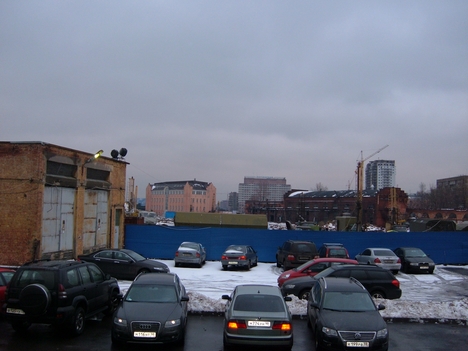Fight over Gazprom tower symbolises modern Russian politics http://www.bdonline.co.uk/story.asp?sectioncode=725&storycode=3101977 Building Design 10 December, 2007
St Petersburg is astonishingly beautiful. In two days in the city, I marvelled at the unending sequence of classical and baroque architecture, the unspoiled proportions of its boulevards and squares, and the flash of a golden spire or cupola as a corner is turned. And I heard how the two opposing lobbies on the controversial Okhta Centre, also known as the Gazprom tower, both presented themselves as the custodians of this amazing architectural heritage.
At a special presentation to Russian and British journalists, RMJM stressed that its competition-winning design for the tower at the centre of the mixed-use Okhta Centre - formerly, and more provocatively named after its client as Gazprom City - is consistent with the city’s overall design integrity. The level skyline is nevertheless punctuated by a series of tall verticals, spires and domes, which set the rest of the city into relief – they include the 122m spire of the Admiralty building, St Peter and Paul Fortress and the dome of St Isaac’s cathedral.
 Spire of Admiralty and dome of St Isaac’s from Palace Square
Spire of Admiralty and dome of St Isaac’s from Palace Square  Gazprom Tower model
Gazprom Tower model “We felt it was right to use the tradition of vertical elements in the city, we wanted to create a spire. Other entrants in the competition weren’t trying to meet the sky in the same way,” says Philip Nikandrov, a RMJM director. And from many vantage points in the historic centre of the city, distance would indeed shrink the city’s newest 396m spire to a scale comparable to its inspirations.
And Nikandrov argued that history offered other precedents – Rastrelli, architect of the State Hermitage Museum and the Smolny Cathedral designed an unbuilt 143m tower. Tatlin’s Tower would have towered 400m over the city in its incarnation as revolutionary Petrograd. To RMJM, their design respectfully draws on the city’s past in order to celebrate its future. “We wanted to bring out [in the presentation] how beautiful the city is, and how we understand it, and how our design celebrates it,” says RMJM’s international design director Tony Kettle.
But to the opposition lobby, the office tower is entirely out of scale. It damages the integrity of St Petersburg as a flat city with a consistent skyline. Crucial views and vistas, particularly along the Neva, would be compromised by its presence. And, sited directly on the opposite side of the riverbank to the self-same Smolny Cathedral, it would dwarf it in scale, so that the high point of Russian baroque architecture would no longer have command of its riverside setting. Rather than respecting the city, it’s a disrespectful affront.
“It’s not a good fit for St Petersburg,” says architect Slava Gaikovich, head of the Studio 17 practice and chairman of the Association of Architecture Practices in St Petersburg “Any new building in St Petersburg is under criticism to some extent, and this is part of RMJM’s case. But the most important thing is that so close to the centre, such a high tower has no right to exist.”
As Gaikovich points out and others agree, the origins of the problem was Gazprom’s competition brief, which BD understands did not stipulate a tower but opened up the possibility of one. So he makes an alternative suggestion that takes into account Gazprom’s interest in a contemporary spire for St Petersburg. “The main idea of a high tower could become a spire, and the main body of the building could be no higher than 100 m. The site and the client’s programme allow us to do that,” he says.
Mikhail Milchik, deputy director general of the Institute of Special Restoration Projects and a conservation adviser to the city, lists the reasons why the tower’s critics are so incensed. The fact that Gazprom’s original competition brief did not respect the local height restriction of 48m, and Unesco’s possible withdrawal of World Heritage status if the tower proceeds.
And, above all, how it would set a worrying precedent. “There can’t be just one tower. If it’s allowed, then other developers will demand the same. The whole system will be destroyed, and we will follow the same path of Moscow. This is a decisive moment - will St Petersburg follow the path of Moscow, or Rome?”
But there are, however, a few things the two sides agree on. The 76 ha site of the proposed Ј1.2 bn Okhta Centre is not in the Unesco-protected historic city centre, but in a so-called “buffer zone”. It would not be seen from many key vantage points in the city, such as the Palace Square, Nevskiy Prospekt or St Isaac’s Cathedral. There is nothing architecturally significant on the site that would be demolished to make way for it. As a secondary riverside location accessible from the centre, it’s the kind of site that city planners the world over would earmark as suitable for regeneration and development.
And one other area where there is at least some degree of agreement is the design. In the words of Gaikovich: “I believe that the intellectual design is of a high level, the idea of a pentagon is interesting. I have respect for the intellectual part of the project, and the team behind this interesting design, even if the result is impossible for me.”
RMJM’s starting point was the Swedish fortress that stood on the site for the second half of the 17th century, and was built in the shape of a five-pointed star. So the tower therefore has a five-sided footprint, wrapped in a curved glass envelope. It consists of five blocks of accommodation separated by atria spaces and arranged around a central core. But the office stacks do not simply rise vertically – each rotates slightly from floor to floor, so that the five elements twist as they taper to the summit. Spaces between the wings form “sky gardens.”
 Model of the Swedish fort
Model of the Swedish fort But the real argument is not over the merits of the design, but the appropriateness of any tower in this location. And it sounds as if many elements of St Petersburg society have cast their vote against it. Milchik describes a unanimous motion passed by the St Petersburg Union of Architects, letters of protest from the official bodies representing the city’s artists, musicians, writers and other creative professions, and the emergence of “Living City”, a pressure group set up by a younger generation of protestors.
“The expressions of protest against the tower have a mass character. It’s even had a positive side to it. Before, people used to be indifferent to the problems, so it’s positive that so many are worried and have become involved,” says Milchik.
But RMJM’s international design director Tony Kettle argues that the tower has become an unwitting punch-bag in a wider political situation, that mud being thrown by opponents of the current regime is sticking to the Okhta centre tower unfairly. “I think the politics have got in the way, and it’s been hi-jacked by people who are against the system,” he says.
To some degree he is right – the tower has become a focal point of a more general dissatisfaction with Putin’s Russia, an emblem of the way the government and the companies it supports seem to act above the law. Street demonstrations held in September were organised by Jabloko, an opposition party, rather than directly by the heritage or architecture camps.
But then the whole background to the tower is political, in the Russian sense. Gazprom, the country’s most powerful company, is closely intertwined with both the government and the St Petersburg administration. The two are paired in a joint venture to build Okhta, the city coffers benefitting from Gazprom’s move from Moscow. If the tower gets planning permission, it will be because the laws passed by the City prohibiting developments over 48m in this area are waived for this “special case” - and that’s politics too.
I heard plenty of other arguments in two days in St Petersburg. About whether or not Unesco’s threat to delist St Petersburg over Okhta is consistent with how it has handled development proposals in other protected cities, for instance the Shard and the Tower of London or Cologne. Disagreements over the degree of public consultation on the project - RMJM’s tower design won a popular vote of St Petersburg residents, and a further round of consultation is planned, but the opponents feel that these are something of a charade.
But many believe, as RMJM does, that Gazprom and the city authorities have the right to do what they think is best for St Petersburg, even if that means bending the law, and the right to develop it along contemporary lines that can nevertheless be traced back to its historic past. If that’s the case, then a spire design in a non-central location is an appropriate way of signaling that St Petersburg is a thriving, contemporary city. “Gazprom is very important to Russia, and why shouldn’t we celebrate that?” Kettle suggested at the presentation.
 The site for the proposed Gazprom tower
The site for the proposed Gazprom tower Even Milchik is forced to agree that the tower does have a considerable degree of popular support. “There are a lot of people who live in the outskirts and don’t understand the historic values of the old city. They think a tower would be an asset, something to be proud of. And so the authorities build their case on this.”
The opponents’ case is built on the belief that St Petersburg draws its power from the way each individual building pays its respects to the consistency, scale and proportions of the whole, and that a tower in this location is an insult to its historic surroundings. Once it’s built, moreover, the city would have abandoned any claim to a strict planning regime, opening the floodgates to a wave of high-rise development.
Next year, there will be another round of public consultation, where a positive result is likely to lead to the city granting itself planning permission and the start of construction as early as next June. Unesco will play it’s hand, possibly demanding design changes, and the City authorities are likely to respond defensively. The opponents will continue a lobbying campaign and rallying popular support, but to feel that the channels of democracy in Russia don’t lead very far.
Readers' comments Thomas Campbell 16 December, 2007
You write that the RMJM project won a "popular vote" of Petersburg residents. However, you fail to mention how this vote was conducted. During the public presentation of all six projects in the competition (Petersburg Academy of Arts, 8-30 November 2006) visitors were handed "ballots" and encouraged to "vote" for one of the six projects. According to the sometimes-reliable Petersburg news website fontanka.ru (http://www.fontanka.ru/2006/12/01/181294/), approximately 13,000 people visited this presentation (I was one of them), and of those visitors approximately 11,000 marked and turned in a ballot. RMJM got 24 percent of those votes, while Daniel Libeskind came in a close second at 23 percent, and Jean Nouvel took 13 percent. If we do the math, it turns out the "popular vote" in favor of RMJM's "corncob" (as it is unaffectionately referred to here in Petersburg) amounted to something between 2500 and 3000 votes -- in a city of around 5 million people. That is, RMJM has the support of a whopping .0006 percent of the population. As someone who witnessed the 7 September march "for the preservation of Petersburg," I can tell you that there were at least 3000 folks in attendance, if not more. So there are at least as many people against the tower as for it. Whatever the case, the demo wasn't organized only by the Yabloko party (as you erroneously point out), but also by a number of other organizations, especially Living City. As fontanka.ru points out in the article I have cited above, visitors to last year's public showing of the projects had no chance to vote "against all" the projects, just as real Russian voters no longer have this opportunity in parliamentary and presidential elections. This "popular vote" was thus a hollow imitation of democracy, which in the wider sense has been mostly trampled to death by the Putin administration over the last eight years. And this makes it all the easier for the Petersburg government and developers to force not only the RMJM corncob down everyone's throat, but all the other numerous new construction projections that are rapidly destroying many of the city's older buildings and ruining its serene views forever. Movements like Living City and other community groups are fighting a good fight, but to say that the forces are inequal in this battle is almost to say nothing. Head of the city preservation committee, Ms. Dementieva's answer to your question about Unesco's concerns also fits a larger pattern among ranking Russian politicians these days: to publicly mock international treaties, conventions and organizations whenever possible. Why? Because the home audience has to be convinced that any complaints against high-official Russian behavior on the part of the Council of Europe, the EU, Unesco, OSCE, Amnesty, etc., are really only expressions of venal self-interest and/or insidious threats to Russia's independence. In other words, the battle over the Gazprom tower really is, as you've argued, as a battle over politics. Since RMJM has come out on the side of Gazprom and Putin, that means their politics are authoritarian tending towards fascist. And how nice of the British Consulate to sponsor this confab! Since they have to juggle such functions with defending the British Council office here from the closure threatened by the Russian Foreign Ministry, their heads must be splitting.





 News Master
News Master





